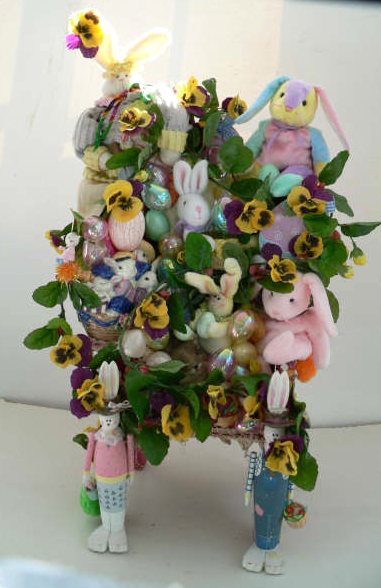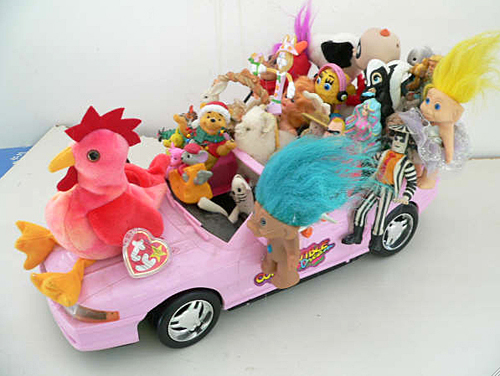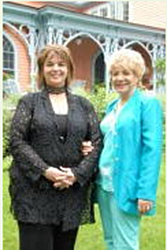Carole Hyatt sharing her collage. on right, a recent work
December 2008
by Nancy Egol Nikkal
Carole Hyatt lives and works in New York City. She is a successful entrepreneur, and always finds ways to share her creative talents with others.
She is the founder of the Carole Hyatt Leadership Forum, and produces Getting to Next, a two-day workshop for 24 women who attend by invitation.
Her life and her workshops are about discovery, generosity, creativity innovation, exploration, opportunity, overcoming fear, and reaching out for and achieving success.
She is also an assemblage artist and makes art.
This interview is about opportunities taken. I thank Carole for her time and thoughtful responses. Following is the interview.
Question: You say you’ve had 7 careers and everyone will have at least 7 careers in their lifetime. Your first career was in the performing arts – and you have always been an artist. How old were you when you first started to perform?
CH: I was 8, and was fortunate to have the singing teacher I had. She only taught adult professionals, but had a young son and wanted to include another child in his class. I got to be that child. My teacher’s husband was the song arranger for Irving Berlin, and I got to sing Berlin’s songs before they hit Broadway! My teacher also managed an entertainment service, and we performed at hospitals, firehouses and public spaces, and parties. I loved to sing and perform – I guess I was a child looking for attention. It was a wonderful experience.
Question: You graduated from Syracuse University with an undergraduate degree in theater and education, and worked as an elementary school teacher.
CH: Because of my theater background, I taught improvisation. The children were acting out everything and learning everything through acting. I thought what we were doing was unique, and thought I had invented a new way for children to learn.

Carole Hyatt: Large Bunnies
What a surprise when I learned it was called “learning dramatics.” By chance I sat next to a man on an airplane and we talked about my work. He told me what I was doing was being taught on the graduate level, and told me about an upcoming creative dramatics conference. He also directed me to the head of the theater department at the University of Denver, CO. Because of that information, I went to the conference and applied to graduate school and got my MA Degree in Children’s Theater and Creative Dramatics from the University of Denver. My first job post-graduate was as head of creative theater and creative dramatics at the Boys’ Clubs of New York in Harlem and the Lower East Side.
Question: At age 22 you created the Peppermint Players with your friend Paul Libin, writing, directing, performing and producing musical fairy tales for young audiences at Town Hall, three off-Broadway theaters and on tour. McGraw Hill distributed the repertoire on film worldwide.
CH: I learned how to do everything at the University of Denver. I stayed with the Peppermint Players for 8 years. Our performances were recorded, broadcast on TV, and distributed as films.
CBS TV was looking for children’s programming, and I was invited to come to CBS. I was one of the first women to produce for television and won an Emmy for the children’s one-hour specials, and introduced Jim Henson and his puppets to CBS TV.
Question: You changed careers again in the late 1960s.
CH: I was at CBS for five years. I was managing the Peppermint Players and teaching graduate level creative dramatics and creative theater at Hunter College (CUNY) and at the New School in NY.
Women weren’t highly accepted in corporate America in the 1960s, and television executives were afraid to hire women. I wasn’t able to create and produce the projects I wants to produce at CBS, and tried to borrow funds to produce independently but banks wouldn’t lend money to women.

Carol Hyatt: Holiday
I changed careers, and formed Hyatt-Esserman Research Associates with June Esserman, a social research scientist. With Dan Yankelovich, we pioneered research documenting the affects of women moving into the workforce. We did consulting work with government agencies and non-profit organizations. The partnership ended after 18 years, when June died suddenly of a heart attack. She was only 52 years old.
Question: How did you meet June Esserman and decide to form Hyatt-Esserman Research Associates?
CH: We had a blind date. I asked June what she did. She explained her work involved quantitative and qualitative market research. Quantitative work is about a lot of numbers. I thought that would be boring. She explained qualitative work involved organizing discussion focus groups to find out what people wanted in order to get market information. I thought that might be interesting.
My philosophy in life is to be open to other people’s ideas, and be willing to try them out. I believe it’s important to act quickly and go along with opportunity, ask the right questions, have no fear of trying new things, and even if you have fears, be willing to try it anyway.
I think people should feel good about trying new things.
Question: How did Getting to Next and the Leadership Forum emerge?
CH: Getting to Next emerged because of opportunity. I was writing and lecturing. I sold Hyatt-Esserman Research Associates after my partner’s death. It was the late 1980s and the economy was in trouble. People lost their jobs and were unsure of what to do next, and I received a lot of calls asking for advice and orders for books I had written. I organized a first meeting. 24 women attended. I organized a second meeting and invited guest speakers. Another 24 women attended. We discovered an amazing thing: The women in business said they wanted to do something in the non-profit sector, and the women working for the non-profits said they wanted to make money. All the women were influential in their fields and were willing to help each other. Many were members of the International Women’s Forum. One was an ex-CEO.

Carole Hyatt: Large Bunnies
They told me I had to repeat the seminars for other women, and sent me names of women to contact, including colleagues, sisters, daughters and even mothers. In 1994 I created the Carole Hyatt Leadership Forum. There are now 1800 alumni worldwide who came from the initial group of 24.
Question: How do you always seize opportunity and see what is next?
CH: We are all creative and all have great ideas, but unless we act on our ideas, nothing gets accomplished. Being innovative means you not only have to think of it you have to do it.
I believe many people are afraid to try because they fear they will fail. I believe it’s important to fail. If we fail, and understand why we failed, we can learn how to do it better.
I learned how to gather people around me who have great talents. With the Alumni Forum, we have a worldwide network, and we can call upon each other for suggestions and help.
Question: I want to return to your other creative side. Please talk about your assemblages. You create art with found media. Your pieces have a playful quality and feel very contemporary.
CH: I love collecting things and love working with found media, and now I have an excuse to collect things. The new series is based on bunnies and the fertility they represent. I am having the best time with the bunnies. Every weekend this summer I found bunnies at tag sales. Bunnies are evidence of the fertility of life, the newness of everything, and possibilities everywhere. All the people around me have gotten so fertile. The Alumni Forum keeps me in touch with all these creative people.
Question: Will you have an exhibition soon?
CH: A group show is coming up, and I hope to have gallery representation in Portland, OR soon.
Question: You love to travel, and trips always include art workshops and sightseeing, local architecture, markets and museums. How has travel influenced your work?
CH: Travel opens up your thinking. When you travel and meet new people and see new places, you no longer feel prejudices about anything. You can meet people and change your life.
I was at an art retreat this summer in Mexico and met Dr. Cheri Florance, and it has changed my life. We sat next to each other and worked together. She was drawing. I was doing collage. She wanted to know more about collage and I was interested in drawing, so we shared ideas about art. I asked her what else she did and found out she is a neuroscientist.

Carole Hyatt & Dr Cheri Florance
I met her because of our interest in art. Now I have a new partner.
Question: You have begun a new project with Dr. Cheri Florance, a two day Brain Innovation Seminar – “Brain Engineering: Super-Charging our Brain for Creativity and Innovation.” It’s brain mapping for men and women.
CH: Through this seminar, people begin to love their brain. At the workshop, participants make a brain print and get to see how their brain really operates. It’s magical. They can learn how to make their brain function better. Brain mapping opens up new channels so you can become more creative and innovative. It’s very thrilling.
Visit http://www.carolehyatt.com for information about Carole and about upcoming workshops.